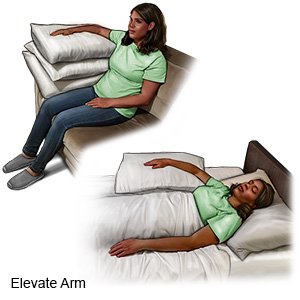De Quervain Release
Medically reviewed by Drugs.com. Last updated on Sep 23, 2025.
De Quervain release is surgery to cut the sheath around your inflamed tendon. The sheath forms a smooth tunnel that your tendon slides through when you move your thumb.
DISCHARGE INSTRUCTIONS:
Call your local emergency department (911 in the US) if:
- You have trouble breathing.
- You have chest pain.
Seek care immediately if:
- Blood soaks through your bandage.
- Your incision comes apart.
Related medications
Call your surgeon or doctor if:
- You have a fever or chills.
- Your incision site is red, swollen, or draining pus.
- You have nausea or are vomiting.
- You feel dizzy or lightheaded.
- You have questions or concerns about your condition or care.
Medicines:
You may need any of the following:
- NSAIDs , such as ibuprofen, help decrease swelling, pain, and fever. NSAIDs can cause stomach bleeding or kidney problems in certain people. If you take blood thinner medicine, always ask your healthcare provider if NSAIDs are safe for you. Always read the medicine label and follow directions.
- Prescription pain medicine may be given. Ask your healthcare provider how to take this medicine safely. Some prescription pain medicines contain acetaminophen. Do not take other medicines that contain acetaminophen without talking to your healthcare provider. Too much acetaminophen may cause liver damage. Prescription pain medicine may cause constipation. Ask your healthcare provider how to prevent or treat constipation.
- Take your medicine as directed. Contact your healthcare provider if you think your medicine is not helping or if you have side effects. Tell your provider if you are allergic to any medicine. Keep a list of the medicines, vitamins, and herbs you take. Include the amounts, and when and why you take them. Bring the list or the pill bottles to follow-up visits. Carry your medicine list with you in case of an emergency.
Self-care:
- Care for the surgery area as directed. You may need to wash the area with soap and water. Dry the area and put on new, clean bandages as directed.
- Apply ice to help decrease swelling and pain. Use an ice pack, or put crushed ice in a plastic bag. Cover the bag with a towel before you place it on your wrist. Apply ice for 15 to 20 minutes every hour, or as directed.
- Elevate your wrist above the level of your heart as often as you can. This will help decrease swelling and pain. Prop your wrist on pillows or blankets to keep it elevated comfortably.

- Move your thumb and hand as directed. This helps prevent stiffness and improves function.
- Go to hand therapy if directed. Hand therapists can teach you exercises to help improve movement and strength, and to decrease pain.
Follow up with your surgeon or doctor as directed:
You will need to return to have your surgery area checked. Write down your questions so you remember to ask them during your visits.
© Copyright Merative 2025 Information is for End User's use only and may not be sold, redistributed or otherwise used for commercial purposes.
The above information is an educational aid only. It is not intended as medical advice for individual conditions or treatments. Talk to your doctor, nurse or pharmacist before following any medical regimen to see if it is safe and effective for you.
Learn more about De Quervain Release
Care guides
- De Quervain Release
- Epidural Steroid Injection
- How to Care for your Child's Midline Catheter
- How to Care for your Child's Picc (Peripherally Inserted Central Catheter)
- How to Care for your Midline Catheter
- How to Care for your Picc (Peripherally Inserted Central Catheter)
- Radiofrequency Ablation of the Kidney
Further information
Always consult your healthcare provider to ensure the information displayed on this page applies to your personal circumstances.
